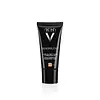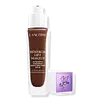What's inside
What's inside
 Key Ingredients
Key Ingredients

 Benefits
Benefits

 Concerns
Concerns

 Ingredients Side-by-side
Ingredients Side-by-side

Water
Skin ConditioningDimethicone
EmollientGlycerin
HumectantSynthetic Fluorphlogopite
Hydroxyethyl Acrylate/Sodium Acryloyldimethyl Taurate Copolymer
Emulsion StabilisingDimethicone Crosspolymer
Emulsion StabilisingSorbitan Isostearate
EmulsifyingTriethanolamine
BufferingSalicylic Acid
MaskingAluminum Hydroxide
EmollientPhenoxyethanol
PreservativeDisodium Stearoyl Glutamate
CleansingEperua Falcata Bark Extract
Skin ProtectingDextrin
AbsorbentPolysorbate 60
EmulsifyingCI 77891
Cosmetic ColorantCI 77491
Cosmetic ColorantCI 77492
Cosmetic ColorantCI 77499
Cosmetic ColorantWater, Dimethicone, Glycerin, Synthetic Fluorphlogopite, Hydroxyethyl Acrylate/Sodium Acryloyldimethyl Taurate Copolymer, Dimethicone Crosspolymer, Sorbitan Isostearate, Triethanolamine, Salicylic Acid, Aluminum Hydroxide, Phenoxyethanol, Disodium Stearoyl Glutamate, Eperua Falcata Bark Extract, Dextrin, Polysorbate 60, CI 77891, CI 77491, CI 77492, CI 77499
Propanediol
SolventCetyl PEG/PPG-10/1 Dimethicone
EmulsifyingPentylene Glycol
Skin ConditioningPolyglyceryl-4 Isostearate
EmulsifyingZea Mays Kernel Extract
Glycine Soja Oil
EmollientCopernicia Cerifera Cera
EmollientIris Florentina Root Extract
MaskingCyathea Medullaris Leaf Extract
Skin ConditioningPEG-10 Dimethicone
Skin ConditioningPEG-30 Glyceryl Stearate
EmulsifyingPEG/PPG-18/18 Dimethicone
EmulsifyingCeramide NP
Skin ConditioningSorbitol
HumectantGlycerin
HumectantGlyceryl Caprylate
EmollientDimethicone
EmollientCaffeine
Skin ConditioningLecithin
EmollientSodium Levulinate
Skin ConditioningSilica Silylate
EmollientCellulose Gum
Emulsion Stabilising2-Oleamido-1,3-Octadecanediol
Skin ConditioningPerlite
AbsorbentAluminum Hydroxide
EmollientGuanosine
Skin ConditioningMagnesium Sulfate
Cinnamic Acid
PerfumingAlcohol Denat.
AntimicrobialPoloxamer 188
EmulsifyingDisodium EDTA
Disodium Stearoyl Glutamate
CleansingHydrolyzed Linseed Extract
Skin ConditioningHydroxypalmitoyl Sphinganine
Skin ConditioningCaprylyl Glycol
EmollientPentasodium Ethylenediamine Tetramethylene Phosphonate
Xanthan Gum
EmulsifyingLevulinic Acid
PerfumingPolycaprolactone
StabilisingBHT
AntioxidantTocopherol
AntioxidantPentaerythrityl Tetra-Di-T-Butyl Hydroxyhydrocinnamate
AntioxidantSorbic Acid
PreservativeSodium Benzoate
MaskingPhenoxyethanol
PreservativeCI 77163
Cosmetic ColorantCI 77491
Cosmetic ColorantCI 77492
Cosmetic ColorantCI 77499
Cosmetic ColorantCI 77891
Cosmetic ColorantMica
Cosmetic ColorantPropanediol, Cetyl PEG/PPG-10/1 Dimethicone, Pentylene Glycol, Polyglyceryl-4 Isostearate, Zea Mays Kernel Extract, Glycine Soja Oil, Copernicia Cerifera Cera, Iris Florentina Root Extract, Cyathea Medullaris Leaf Extract, PEG-10 Dimethicone, PEG-30 Glyceryl Stearate, PEG/PPG-18/18 Dimethicone, Ceramide NP, Sorbitol, Glycerin, Glyceryl Caprylate, Dimethicone, Caffeine, Lecithin, Sodium Levulinate, Silica Silylate, Cellulose Gum, 2-Oleamido-1,3-Octadecanediol, Perlite, Aluminum Hydroxide, Guanosine, Magnesium Sulfate, Cinnamic Acid, Alcohol Denat., Poloxamer 188, Disodium EDTA, Disodium Stearoyl Glutamate, Hydrolyzed Linseed Extract, Hydroxypalmitoyl Sphinganine, Caprylyl Glycol, Pentasodium Ethylenediamine Tetramethylene Phosphonate, Xanthan Gum, Levulinic Acid, Polycaprolactone, BHT, Tocopherol, Pentaerythrityl Tetra-Di-T-Butyl Hydroxyhydrocinnamate, Sorbic Acid, Sodium Benzoate, Phenoxyethanol, CI 77163, CI 77491, CI 77492, CI 77499, CI 77891, Mica
Ingredients Explained
These ingredients are found in both products.
Ingredients higher up in an ingredient list are typically present in a larger amount.
Aluminum Hydroxide is a form of aluminum. It can be naturally found in nature as the mineral gibbsite. In cosmetics, Aluminum Hydroxide is used as a colorant, pH adjuster, and absorbent.
As a colorant, Aluminum Hydroxide may add opacity, or reduce the transparency. Aluminum hydroxide is contains both basic and acidic properties.
According to manufacturers, this ingredient is an emollient and humectant. This means it helps hydrate the skin.
In medicine, this ingredient is used to help relieve heartburn and help heal ulcers.
There is currently no credible scientific evidence linking aluminum hydroxide in cosmetics to increased cancer risk.
Major health organizations allow the use of aluminum hydroxide in personal care products and have not flagged it as a carcinogenic risk at typical usage levels.
Learn more about Aluminum HydroxideCi 77491 is also hydrated iron III oxide. It's sole purpose is to give a red/pink hue to products.
Iron III oxides are classified as inorganic chemicals for coloring.
Synthetically created Ci 77491 is considered safer than those naturally found. This is because the synthetically created version may contain less impurities. Iron oxides are generally non-toxic and non-allergenic.
Learn more about CI 77491Ci 77492 is also hydrated iron III oxide. It's sole purpose is to give a yellow hue to products.
Iron III oxides are classified as inorganic chemicals for coloring.
Synthetically created Ci 77492 is considered safer than those naturally found. This is because the synthetically created version may contain less impurities. Iron oxides are generally non-toxic and non-allergenic.
Learn more about CI 77492Ci 77499 is also hydrated iron III oxide. It is created from mixing red and black iron oxides. This helps give shades of darkness to a product.
Iron III oxides are classified as inorganic chemicals for coloring.
Ci 77891 is a white pigment from Titanium dioxide. It is naturally found in minerals such as rutile and ilmenite.
It's main function is to add a white color to cosmetics. It can also be mixed with other colors to create different shades.
Ci 77891 is commonly found in sunscreens due to its ability to block UV rays.
Learn more about CI 77891Dimethicone is a type of synthetic silicone created from natural materials such as quartz.
What it does:
Dimethicone comes in different viscosities:
Depending on the viscosity, dimethicone has different properties.
Ingredients lists don't always show which type is used, so we recommend reaching out to the brand if you have questions about the viscosity.
This ingredient is unlikely to cause irritation because it does not get absorbed into skin. However, people with silicone allergies should be careful about using this ingredient.
Note: Dimethicone may contribute to pilling. This is because it is not oil or water soluble, so pilling may occur when layered with products. When mixed with heavy oils in a formula, the outcome is also quite greasy.
Learn more about DimethiconeDSG is used as a surfactant.
Surfactants are cleansing ingredients that help remove oil, dirt, and other impurities from the skin. They work by reducing surface tension between water and oils/dirt to allow them to be easily rinsed away.
Glycerin is already naturally found in your skin. It helps moisturize and protect your skin.
A study from 2016 found glycerin to be more effective as a humectant than AHAs and hyaluronic acid.
As a humectant, it helps the skin stay hydrated by pulling moisture to your skin. The low molecular weight of glycerin allows it to pull moisture into the deeper layers of your skin.
Hydrated skin improves your skin barrier; Your skin barrier helps protect against irritants and bacteria.
Glycerin has also been found to have antimicrobial and antiviral properties. Due to these properties, glycerin is often used in wound and burn treatments.
In cosmetics, glycerin is usually derived from plants such as soybean or palm. However, it can also be sourced from animals, such as tallow or animal fat.
This ingredient is organic, colorless, odorless, and non-toxic.
Glycerin is the name for this ingredient in American English. British English uses Glycerol/Glycerine.
Learn more about GlycerinPhenoxyethanol is a preservative that has germicide, antimicrobial, and aromatic properties. Studies show that phenoxyethanol can prevent microbial growth. By itself, it has a scent that is similar to that of a rose.
It's often used in formulations along with Caprylyl Glycol to preserve the shelf life of products.